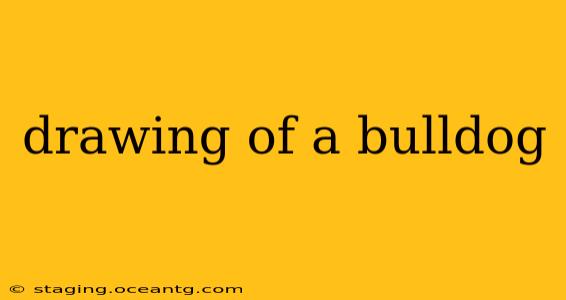Drawing a Bulldog: A Comprehensive Guide for Beginners and Beyond
Drawing a bulldog can be a rewarding experience, whether you're a seasoned artist or just starting out. These lovable, wrinkly dogs offer a unique challenge with their distinctive features. This guide will walk you through the process, addressing common questions and providing tips for achieving a realistic and expressive portrait.
What are the essential features of a bulldog to capture in a drawing?
The key to a successful bulldog drawing lies in capturing its characteristic features. These include the broad, square head, the short, pushed-in nose, the underbite, the loose, wrinkled skin, and the stocky, muscular build. Pay close attention to the shape and placement of the eyes, ears, and wrinkles. Even subtle details, like the way the wrinkles fall around the muzzle and forehead, will add significantly to the realism of your drawing.
How do I draw a bulldog's head?
Start with basic shapes. Think of the head as a square or a slightly elongated cube. Then, gently round off the corners. The muzzle is relatively short and broad, almost like a truncated cone. Carefully observe the placement of the eyes – they're relatively low on the face, often appearing somewhat small compared to the overall head size. Remember the characteristic wrinkles – sketch them in lightly initially, then refine them as you progress.
What materials are best for drawing a bulldog?
The materials you choose depend on your personal preference and desired style. Pencils (H2 for light sketching, 2B or 4B for darker lines and shading) are a great starting point. Charcoal pencils can provide a softer, more expressive look. If you're aiming for a more detailed and refined drawing, you might consider using colored pencils or even watercolors. Experiment to discover what best suits your style.
What are some tips for drawing a bulldog's wrinkles?
The wrinkles are a defining feature of a bulldog's face. Avoid drawing them as individual, separate lines. Instead, focus on the overall flow and form of the wrinkles. Consider how light and shadow play across the wrinkled skin; this will help to create a three-dimensional effect and add depth to your drawing. Use light, short strokes to suggest the texture of the skin, building up the layers of wrinkles gradually.
How do I draw a bulldog's body?
Bulldogs are known for their compact and muscular bodies. Begin with basic shapes – circles and ovals for the chest, abdomen, and hindquarters. Connect these shapes to create a sturdy, low-slung body. Pay attention to the powerful legs and broad chest. Remember to indicate the musculature, especially in the shoulders and legs, without overdoing it.
Are there different bulldog breeds that affect the drawing style?
While the English Bulldog is the most commonly depicted, there are variations within the breed, and other bulldog types exist, like the American Bulldog or the Olde English Bulldogge. These variations can subtly affect the overall proportions and features. Researching the specific breed you're drawing will help you ensure accuracy and realism in your depiction.
How can I add expression to my bulldog drawing?
The eyes are crucial for conveying expression. Carefully observe the placement and shape of the eyes; slightly tilted eyes can create a mischievous or alert look. The position of the mouth and the details of the wrinkles around the mouth also contribute significantly to the expression. Consider the overall posture of the dog – a relaxed posture will convey a different expression than an alert or playful one.
By carefully observing the key features and applying these techniques, you'll be well on your way to creating a stunning and expressive bulldog drawing. Remember, practice makes perfect! The more you draw, the more confident and skilled you'll become. Don't be afraid to experiment with different styles and techniques to find what works best for you.
